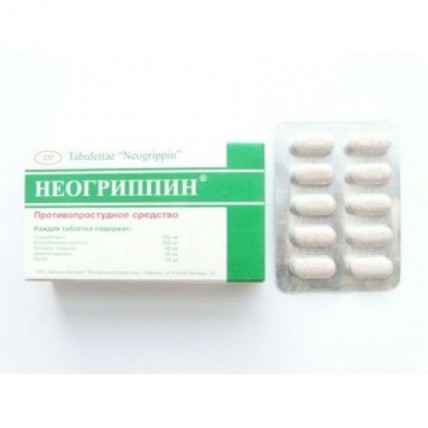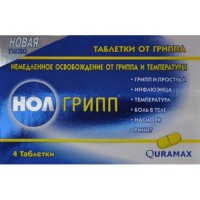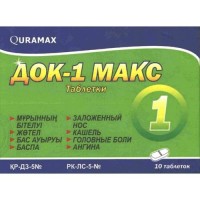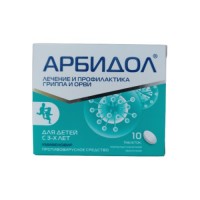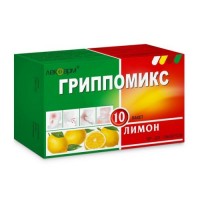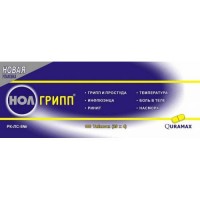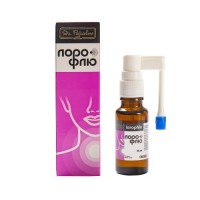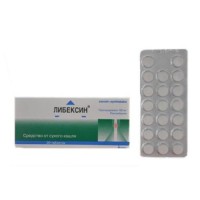The instruction on medical the Trade name Neogrippin Mezhdunarodnoye the unlicensed name Is not present primeneniyulekarstvenny means of Neogrippin the Dosage form of the Tablet Structure One Tablet contains active agents: paracetamol of 250.0 mg of calcium ascorbic acid of 150.0 mg gluconate of 50.0 mg difengidramin hydrochloride of 10.0 mg of routines of 10.0 mg excipients: corn starch, magnesium stearate, talc, lactose, karmoizin (E 122). The description of the Tablet of pink color with green impregnations, an oval form and risky. Pharmacotherapeutic group Drugs for treatment of diseases of a respiratory system. Drugs for elimination of symptoms of cold and cough. Other combinations of drugs for elimination of symptoms of cold. The ATX R05X code the Pharmacological Pharmacokinetics Paracetamol At properties intake is quickly absorbed from digestive tract. In a human body the ratio between paracetamol level in whole blood and plasma is close to 1. In saliva drug comes to light in the concentration correlating with paracetamol content in plasma. The maximum level in blood plasma is reached in 30-60 min. Paracetamol is quickly and evenly distributed on body tissues. The ability of paracetamol to get into brain fabric where it is evenly distributed is high. The exception makes a hypophysis in which the content of drug is 2-3 times higher, than in other structures of a brain. At the same time paracetamol is quicker removed from brain fabric, than salicylates. Less long febrifugal effect of drug in comparison with aspirin is connected with it. In mother's milk the content of paracetamol does not exceed 1%. After prescribing of paracetamol in a dose of 10-15 mg/kg the medical effect coming usually in 30 min. lasts for 2-4 h. Linking with proteins of blood plasma makes 80-15% of the accepted dose. Raspredelyaemost volume sizes at children and adults significantly do not differ. Drug breaks a placental barrier. Elimination happens generally by biotransformation in a liver - up to 90-95% of the accepted dose. Paracetamol is metabolized by microsomal enzymes of a liver. About 80% form conjugates with glucuronic acid and sulfates, up to 17% is exposed to hydroxylation with formation of active metabolites which conjugate with glutathione. At overdose or a lack of glutathione these metabolites can cause necrosis of hepatocytes. The delay of removal of paracetamol and its metabolites is observed at disturbance of renal function and at patients with chronic diseases of a liver. The half-cycle of its removal from an organism makes 1.5-2 h. It can increase at patients with the profound renal failures, a liver and elderly patients. In 24 hours of 85-90% of a dose 3% in an invariable look are removed with urine in the form of glyukoronid and sulfates, and. Ascorbic acid (vitamin C) Ascorbic acid is well soaked up in digestive tract and easily distributed in body tissues. Biodigestion of ascorbic acid is about 70%. Plasma concentration of ascorbic acid increases at intake of substance in digestive tract up to the certain size. It occurs at daily administration of drug in a dose of 90 - 150 mg daily. Stocks in an organism of ascorbic acid at the healthy person make 1.5 g. Biotransformation of ascorbic acid occurs in a liver. It reversibly is oxidized to dehydroascorbic acid, is partially metabolized to ascorbate-2-sulfate, being neutral and oxalic acid which are allocated with urine. Ascorbic acid in the dose exceeding requirement of an organism eliminirutsya quickly with urine. The gluconate of calcium Is soaked up generally in a small intestine. Biodigestion of drug in digestive tract low. About one third of the arrived calcium is absorbed though it in many respects depends on a diet and a condition of a small intestine. Absorption is increased at deficiency of calcium and in the period of high physiological requirements, for example at children's age, or at pregnancy and feeding by a breast. 50% of the general calcium of serum are provided by the ionized calcium, 5% are in structure of anion complexes and 45% are connected with proteins. Unabsorbed calcium is removed with urine - 20% and with a stake - 80%. With a stake it is removed as not absorbed calcium, and that its absorbed part which is allocated with bile and pancreatic secretion. Insignificant quantities are lost with then, hair and nails. Difengidramin a hydrochloride (Dimedrol) is Quickly soaked up in a GIT. Bioavailability about 50%. It is actively metabolized mainly in a liver, partially — in lungs and kidneys. The peak of plasma concentration is reached in 1 – 4 hour after appointment inside. Drug well gets into all body tissues (most of all in lungs, a spleen, kidneys, a liver, a brain and muscles). During the day it is completely brought out of an organism with urine in the form of the metabolites conjugated with glucuronic acid, the insignificant quantity is distinguished in not changed look. Difengidramin passes a placenta and is defined in breast milk. Drug highly communicates proteins of plasma – up to 98-99%. Biological half-life of 4-10 h. Full removal of drug happens in 24 hours after appointment. In a liver failure the dose adjustment towards reduction is necessary. Rutinum (vitamin P) of Bioflavonoida — various group of vegetable polyphenolic connections. It is quickly soaked up from digestive tract. In body tissues turns into phenolic acids which are emitted with urine. Partially flavonoids can be allocated in not changed look or in conjugates with glucuronic and sulfuric acids. The pharmacodynamics Paracetamol well gets through a blood-brain barrier. Its central soothing and febrifugal action by means of reduction of threshold level of these processes, by impact on the centers of thermal control and pain in a hypothalamus by prostaglandinsintetaza enzyme blockade is connected with it that interferes with synthesis of prostaglandins. It eliminates their impact on the centers of thermal control leading to decrease in body temperature. Loss of heat a body at feverish states increases in result of vasodilatation and increase in resilience of a peripheral blood-groove. Besides, the soothing effect of paracetamol is connected with peripheral blocking of impulses on the bradikininchuvstvitelny chemoceptors responsible for developing of pain. Owing to an acute inflammation there is a microcirculation disturbance, first of all microcirculation. It leads to change of sensitivity of the pain receptors which are located on the course of blood vessels. The febrifugal effect of paracetamol, as well as other non-steroidal anti-inflammatory drugs, consists in decrease in feverish, but not normal body temperature. In the inflamed fabrics cellular peroxidases neutralize influence of paracetamol on cyclooxygenase that explains almost total absence of anti-inflammatory action. Ascorbic acid (Vitamin C) takes part in many types of redoxreactions in an organism. The major representatives are L-ascorbic acid and its oxidized form - dehydroascorbic acid. The main property of the specified connections – antioxidant. Ascorbic acid slows down processes of peroxide oxidation of lipids, proteins and other components of a cell, than protects it from damage. Vitamin C increases concentration of interferon in blood. The membrane stabilizing effect of vitamin C and its immunomodulatory action is connected with it. Vitamin C is capable to collect in leukocytes, increasing their phagocytal activity that increases antimicrobial and antiviral protection. Ascorbic acid activates biosynthesis of kortikoidny hormones in bark of adrenal glands and by that stimulates adaptive processes of an organism in stresses. Pathology of digestive tract interferes with digestion of ascorbic acid. At deficiency of vitamin C the risk of developing catarrhal diseases increases, cholesterol level in blood increases, bleeding of gums, increased fatigue and so forth develops. Rutinum - a plant glycoside. Belongs to group of bioflavonoids which can be used for creation of biologically important connections in a cell, in particular an ubikhinona. It is capable to reduce capillary bleeding due to strengthening of walls of blood vessels which permeability during a viral infection increases. Rutinum favorably influences maintenance of normal level of the immune system. Difengidramin hydrochloride (Dimedrol) competitive blocker of H1-histamine receptors. It has the significant antihistaminic activity (weakens reaction of an organism to an endogenous and exogenous histamine). Besides, it has mestnoanesteziruyushchy effect, relaxes smooth muscles as a result of direct spasmolytic action blocks holinoretseptor of vegetative ganglia in moderate degree. Reduces permeability of capillaries, prevents histamine hypostasis of fabrics and histamine hypotension and by that reduces permeability of vessels, eliminates puffiness and hyperaemia of a mucous membrane of a nose, irritation in a throat, allergic reactions from upper airways. Dimedrol is well soaked up at intake. Gets through a blood-brain barrier. Important feature of Dimedrol is its sedative action having some similarity to effect of antipsychotic substances. In the corresponding doses it renders somnolent effect. Is also moderate antiemetic. In operation Dimedrol on nervous system its central cholinolytic activity has essential value along with influence on histamine receptors (perhaps, brain H3 receptors). Dimedrol is applied generally at treatment of an urticaria, hay fever, serum disease, hemorrhagic vasculitis (capillary toxicosis), vasomotorial cold, Quincke's disease, a pruritic dermatosis, an acute iridocyclitis, allergic conjunctivitis and other allergic diseases, allergic complications for intake of various drugs, including antibiotics. As well as other antihistaminic drugs, Dimedrol it is applied at treatment of radiation sickness. In bronchial asthma Dimedrol is a little active, however it is possible to appoint it in this disease in combination with theophylline, ephedrine and other medicines. Calcium the gluconate fills shortage of calcium ions, has antiallergic, weak central sedative effect, anti-inflammatory, haemo static and disintoxication action. Calcium ions are necessary for implementation of process of transfer of nervous impulses, reduction of skeletal and unstriated muscles, activity of a muscle of heart, forming of a bone tissue, fibrillation. Calcium reduces permeability of cells and a vascular wall, prevents development of inflammatory reactions, increases body resistance to infections and can strengthen considerably phagocytosis (the phagocytosis decreasing after intake of sodium chloride increases after intake of calcium). At intravenous administration stimulates sympathetic department of the autonomic nervous system, strengthens discharge adrenaline adrenal glands, has moderate diuretic effect. Indications - febrifuge in catarrhal diseases - sedative in myalgia, neuralgia, a headache. The route of administration and doses Appoint inside on 1 tablet 3 times a day. The maximum single dose for adults - 2 tablets, daily – 6 tablets. More than 5 days without consultation with the doctor are not recommended to use drug. If symptoms remain, it is necessary to see a doctor. Not to exceed the recommended doses. Side effects In the list given below are provided side effects depending on a system and organ class. In each System and organ class reactions depending on the frequency of their emergence are provided: very often (≥ 1/10), it is frequent (≥ 1/100 to & lt, 1/10), infrequently (≥ 1/1,000 to & lt, 1/100), is rare (≥ 1/10,000 to & lt, 1/1,000), is very rare (& lt, 1/10,000). Often: - the dispepsichesky phenomena, dryness in a mouth, pain in epigastriums, nausea, vomiting, diarrhea, a constipation, irritation of a mucous membrane of digestive tract, stomach spasms - allergic reactions: urticaria, skin itching, dermahemia Seldom: - acute anaphylaxis Very seldom: - a headache, feeling of fatigue, drowsiness, increase in excitability of central nervous system, a sleep disorder, reduction in the rate of psychomotor reactions, at children perhaps paradoxical development of insomnia, irritability and euphoria, a disorientation in time and space, a delirium, deterioration in short-term memory, easing of attention - a thrombocytosis, thrombocytopenia, a leukopenia, a neutropenia, an agranulocytosis, anemia, hemolytic anemia (especially for patients with deficit glyukozo-6-fosfatdegidrogenazy), a giperprotrombinemiya, an erythropenia, a neutrophylic leukocytosis, a hypopotassemia, Is unknown: - a heavy renal or liver failure - at prolonged use in high doses the oppression of function of the insulyarny device of a pancreas (hyperglycemia, a glucosuria), a hyperoxaluria and formation of urinary stones from calcium oxalate, damage of the glomerular device of kidneys - disbolism, feeling of heat is possible, at prolonged use of high doses – a delay of sodium and liquid, disturbance of exchange of zinc, copper - reduced sweating in combination with the increased body temperature, sexual dysfunction, aggravation of symptoms in glaucoma - a hypercalcemia (nausea, vomiting, diarrhea, bradycardia) can be observed after intake at patients with a renal failure or with a concomitant use of vitamin D - decrease in permeability of capillaries and deterioration in a trophicity of fabrics, fibrinferments - when exceeding a dosage: increase in arterial blood pressure, development of mikroangiopatiya, a myocardial dystrophy - the complicated urination (especially at men with the increased prostate) - the increased viscosity of secretion of respiratory tract - at prolonged use in high doses can have hepatotoxic, nephrotoxic action the Patient has to be warned about all side effects including which are not stated above it is necessary to tell the attending physician and to stop administration of drug. Contraindications - individual intolerance of any components which are a part of drug - heavy abnormal liver functions and kidneys - an alcoholism - digestive tract erosive cankers (in an aggravation phase) - gastrointestinal bleedings - blood diseases with tendency to hemorrhages - a nephrolithiasis (or presence of this disease in the anamnesis) - epilepsy - children's age up to 18 years - pregnancy and the period of a lactation - anemia, a leukopenia - deficit glyukozo-6-fosfatdegidrogenazy - it is contraindicated to persons with hereditary intolerance of a galactose, a galactosemia or malabsorption of a glyukozogalaktoza Medicinal interactions Paracetamol. Probenetsid, the isoniazid, Cimetidinum, ranitidine, propranolol, increase elimination half-life and reduce clearance of paracetamol. At use together with the drugs causing induction of enzymes of a liver (Salicylamidum, barbiturates, antiepileptic drugs, tricyclic antidepressants, alcohol, rifampicin) the level of toxic metabolites of paracetamol increases. At use along with chloramphenicol the elimination half-life of the last increases and its toxicity increases. At simultaneous use with oral anticoagulants the prothrombin time is extended, the danger of bleedings increases. Simultaneous use with doxorubicine increases risk of an abnormal liver function. Metoclopramidum and domperidol strengthen paracetamol absorption, and holestiramin reduces it. Simultaneous use with doxorubicine increases risk of an abnormal liver function. At simultaneous use with oral contraceptives the removal of paracetamol from an organism accelerates and reduction of its analgetic action is possible. Activated carbon decreases bioavailability of paracetamol. At simultaneous use with anticoagulants perhaps small or moderate increase in a prothrombin time, the danger of bleedings increases. At simultaneous use with metaklopromidy and domperidony increase in absorption of paracetamol and increase in its concentration in blood plasma is possible, and caring
for tyramine reduces concentration of paracetamol. Cases of manifestation of toxic effect of paracetamol at simultaneous use with an isoniazid are described, reduces clearance of paracetamol. Hepatotoxicity cases at simultaneous use of paracetamol and phenobarbital are described. Hepatotoxic action amplifies in the presence of ethanol. Carbamazepine, Phenytoinum, phenobarbital, Primidonum reduce efficiency of paracetamol. Interaction with drugs arises at prolonged use of high doses of ascorbic acid more often. Ascorbic acid increases concentration in blood of salicylates (increases risk of a crystalluria), ethinylestradiol, benzylpenicillin and tetracyclines. With estrogen - hormone level in blood serum increases. With the oral kotratseptiva containing estrogen - the contraceptive effect decreases. Reduces anti-coagulative effect of derivatives of coumarin and heparin. Improves absorption in intestines of iron preparations. Increases the general clearance of alcohol which in turn, reduces concentration of ascorbic acid. Drugs of a quinolinic row, Calcii chloridum, salicylates, corticosteroids at prolonged use exhaust reserves of ascorbic acid. Acetylsalicylic acid, oral contraceptives, fresh juice and alkaline drink reduce absorption and digestion of ascorbic acid. At simultaneous use of ascorbic acid with izoprenaliny the chronotropic action of the last decreases. In high doses increases removal of a meksiletin kidneys. Barbiturates and a pyrimidine increase removal of ascorbic acid with urine. Ascorbic acid reduces therapeutic action of antipsychotic HP (neuroleptics) – derivatives of a fenotiazin, a canalicular reabsorption of amphetamine and tricyclic antidepressants. At simultaneous use, Dimedrol strengthens effect of ethanol and the drugs oppressing central nervous system, barbiturates, somnolent, opiate analgetics. Therefore at combined use of these drugs it is necessary to consult with the doctor for avoidance of the potentiated action. MAO inhibitors enhance anticholinergic activity of Dimedrol. Antagonistic interaction is noted at joint appointment with psychostimulants. Reduces efficiency of Apomorphinum as vomitive at treatment of poisoning. Enhances anticholinergic effects of drugs with holinoblokiruyushchy activity. Calcium can reduce absorption of tetracycline antibiotics and drugs of fluorine at their concomitant use. Simultaneous use of vitamin D increases calcium absorption. Because of a possibility of formation of not soaking up complexes calcium can reduce absorption of estramustinum, the etidronat and, perhaps, other bisfosfonat, Phenytoinum, hinolon, oral tetracycline antibiotics and drugs has to make at least 3 h. Absorption of calcium from a GIT can decrease at a concomitant use of some types of food, for example, of spinach, a rhubarb, bran and grain. When assigning high doses of calcium the patient receiving foxglove drugs can increase risk of developing of arrhythmias. Thiazide diuretics reduce excretion of calcium with urine. Therefore it must be kept in mind risk of development of a hypercalcemia at their simultaneous use. The pharmacological effect of Rutinum amplifies ascorbic acid. Rutinum protects ascorbic acid and adrenaline from oxidation. The special instructions Paracetamol care are appointed in chronic diseases of a liver and kidneys, gout, a peptic ulcer of a stomach and a duodenum (in the anamnesis). It is necessary to consider degree and the nature of functional changes of data of bodies as at these patients the increase in time of semi-removal of paracetamol is possible. Intake of paracetamol can affect results of definition of uric acid in blood by means of phosphatotungstic acid and definition of a glycemia by method glyukozo - oxidases-peroxidases. At administration of drug and during manifestation of its action the consumption of alcoholic beverages is forbidden. Ascorbic acid can distort results of various laboratory tests (determination of content of glucose, bilirubin and activity of hepatic transaminases, LDG in blood plasma). Ascorbic acid is appointed with care to patients with a giperoksalaturiya. Patients need to apply a gluconate of calcium with care with a renal failure, or in the diseases connected with the increased vitamin D level, zabolevanyakh like a sarcoidosis. Prolonged use of Neogrippin (more than 7 days) is not recommended. It is necessary to report about all side (unusual) effects including which are not stated above to the attending physician. In the absence of improvement of health administration of drug it is necessary to stop and see a doctor. If surgical intervention is necessary to the patient, he has to warn the doctor about administration of drug in advance. Pregnancy and the period of a lactation Use of drug during pregnancy and a lactation is not recommended. Features of influence of drug on ability to run the vehicle or potentially dangerous mechanisms With care apply at the patients who are engaged in potentially dangerous types of activity requiring special attention and fast psychomotor reactions. Overdose Symptoms: nausea, vomiting, abdominal pain, perspiration, pallor of integuments, tachycardia. In slight intoxications a ring in ears. Heavy intoxication - drowsiness, spasms, an anury, bleedings, the progressing breath paralysis, respiratory acidosis. Signs of a hypercalcemia include anorexia, nausea, vomiting, a constipation, an abdominal pain, muscle weakness, consciousness disturbance, a polyuria, a nephrocalcinosis, a calciuria and in serious cases cardiac arrhythmia and a coma. At suspicion of poisoning it is necessary to ask for medical assistance immediately. Treatment: to quickly wash out a stomach, to accept salt laxatives, activated carbon with the subsequent prescribing of N-Acetylcysteinum or methionine inside. It leads to normalization of content of paracetamol in blood and to its removal from digestive tract. This therapy is carried out in toxicological department. In the conditions of medical institution - carrying out an artificial diuresis, a hemodialysis, at development of a convulsive syndrome - intravenous administration of anticonvulsant drugs. Antidote in poisoning with paracetamol Acetylcysteinum. Exhaustion warns and promotes increase in synthesis of the intracellular glutathione participating in oxidation-reduction processes of cells, thus, promoting a detoxication of hazardous substances. The form of release and packing On 10 tablets place in blister strip packaging from a film of the polyvinylchloride and printing aluminum foil varnished. On the 2nd blister strip packaging together with the instruction for medical use in the state and Russian languages place in a cardboard pack. To Store storage conditions in the dry, protected from light place at a temperature not above 25 °C. To store out of children's reach! A period of storage 3 years After an expiration date not to apply Prescription status According to the prescription Prozvoditel "Kwality Pharmaceuticals (PVT) Ltd." India, Tung tree Bala, Madzhita Road, Amritsar-143004 Packer of limited liability partnership "Denovo Impex, Kazakhstan Republic of Kazakhstan, Almaty, Utegen St. of the batyr, 13 Ph.: (7272) 771998 E-mail: denovokz@rambler.ru Owner of the registration certificate and packer of limited liability partnership "Denovo Impex, Kazakhstan Republic of Kazakhstan, Almaty, st. Utegen of the batyr, 13 Ph.: (7272) 771998 E-mail: denovokz@rambler.ru the Address of the organization accepting in the territory of the Republic of Kazakhstan claims from consumers on quality of products (goods): Limited liability partnership "Denovo Impex, Kazakhstan Republic of Kazakhstan, Almaty, Utegen St. of the batyr, 13 Ph.: (7272) 771998 E-mail: denovokz@rambler.ru Address of the organization responsible for post-registration observation of safety of medicine Republic of Kazakhstan, Almaty, Bogenbay St. of the batyr, 136. Ph.: (7272) 72-57-51, +7 777 211 72 97. E-mail: doctorkvi@gmail.com.
To develop
for tyramine reduces concentration of paracetamol. Cases of manifestation of toxic effect of paracetamol at simultaneous use with an isoniazid are described, reduces clearance of paracetamol. Hepatotoxicity cases at simultaneous use of paracetamol and phenobarbital are described. Hepatotoxic action amplifies in the presence of ethanol. Carbamazepine, Phenytoinum, phenobarbital, Primidonum reduce efficiency of paracetamol. Interaction with drugs arises at prolonged use of high doses of ascorbic acid more often. Ascorbic acid increases concentration in blood of salicylates (increases risk of a crystalluria), ethinylestradiol, benzylpenicillin and tetracyclines. With estrogen - hormone level in blood serum increases. With the oral kotratseptiva containing estrogen - the contraceptive effect decreases. Reduces anti-coagulative effect of derivatives of coumarin and heparin. Improves absorption in intestines of iron preparations. Increases the general clearance of alcohol which in turn, reduces concentration of ascorbic acid. Drugs of a quinolinic row, Calcii chloridum, salicylates, corticosteroids at prolonged use exhaust reserves of ascorbic acid. Acetylsalicylic acid, oral contraceptives, fresh juice and alkaline drink reduce absorption and digestion of ascorbic acid. At simultaneous use of ascorbic acid with izoprenaliny the chronotropic action of the last decreases. In high doses increases removal of a meksiletin kidneys. Barbiturates and a pyrimidine increase removal of ascorbic acid with urine. Ascorbic acid reduces therapeutic action of antipsychotic HP (neuroleptics) – derivatives of a fenotiazin, a canalicular reabsorption of amphetamine and tricyclic antidepressants. At simultaneous use, Dimedrol strengthens effect of ethanol and the drugs oppressing central nervous system, barbiturates, somnolent, opiate analgetics. Therefore at combined use of these drugs it is necessary to consult with the doctor for avoidance of the potentiated action. MAO inhibitors enhance anticholinergic activity of Dimedrol. Antagonistic interaction is noted at joint appointment with psychostimulants. Reduces efficiency of Apomorphinum as vomitive at treatment of poisoning. Enhances anticholinergic effects of drugs with holinoblokiruyushchy activity. Calcium can reduce absorption of tetracycline antibiotics and drugs of fluorine at their concomitant use. Simultaneous use of vitamin D increases calcium absorption. Because of a possibility of formation of not soaking up complexes calcium can reduce absorption of estramustinum, the etidronat and, perhaps, other bisfosfonat, Phenytoinum, hinolon, oral tetracycline antibiotics and drugs has to make at least 3 h. Absorption of calcium from a GIT can decrease at a concomitant use of some types of food, for example, of spinach, a rhubarb, bran and grain. When assigning high doses of calcium the patient receiving foxglove drugs can increase risk of developing of arrhythmias. Thiazide diuretics reduce excretion of calcium with urine. Therefore it must be kept in mind risk of development of a hypercalcemia at their simultaneous use. The pharmacological effect of Rutinum amplifies ascorbic acid. Rutinum protects ascorbic acid and adrenaline from oxidation. The special instructions Paracetamol care are appointed in chronic diseases of a liver and kidneys, gout, a peptic ulcer of a stomach and a duodenum (in the anamnesis). It is necessary to consider degree and the nature of functional changes of data of bodies as at these patients the increase in time of semi-removal of paracetamol is possible. Intake of paracetamol can affect results of definition of uric acid in blood by means of phosphatotungstic acid and definition of a glycemia by method glyukozo - oxidases-peroxidases. At administration of drug and during manifestation of its action the consumption of alcoholic beverages is forbidden. Ascorbic acid can distort results of various laboratory tests (determination of content of glucose, bilirubin and activity of hepatic transaminases, LDG in blood plasma). Ascorbic acid is appointed with care to patients with a giperoksalaturiya. Patients need to apply a gluconate of calcium with care with a renal failure, or in the diseases connected with the increased vitamin D level, zabolevanyakh like a sarcoidosis. Prolonged use of Neogrippin (more than 7 days) is not recommended. It is necessary to report about all side (unusual) effects including which are not stated above to the attending physician. In the absence of improvement of health administration of drug it is necessary to stop and see a doctor. If surgical intervention is necessary to the patient, he has to warn the doctor about administration of drug in advance. Pregnancy and the period of a lactation Use of drug during pregnancy and a lactation is not recommended. Features of influence of drug on ability to run the vehicle or potentially dangerous mechanisms With care apply at the patients who are engaged in potentially dangerous types of activity requiring special attention and fast psychomotor reactions. Overdose Symptoms: nausea, vomiting, abdominal pain, perspiration, pallor of integuments, tachycardia. In slight intoxications a ring in ears. Heavy intoxication - drowsiness, spasms, an anury, bleedings, the progressing breath paralysis, respiratory acidosis. Signs of a hypercalcemia include anorexia, nausea, vomiting, a constipation, an abdominal pain, muscle weakness, consciousness disturbance, a polyuria, a nephrocalcinosis, a calciuria and in serious cases cardiac arrhythmia and a coma. At suspicion of poisoning it is necessary to ask for medical assistance immediately. Treatment: to quickly wash out a stomach, to accept salt laxatives, activated carbon with the subsequent prescribing of N-Acetylcysteinum or methionine inside. It leads to normalization of content of paracetamol in blood and to its removal from digestive tract. This therapy is carried out in toxicological department. In the conditions of medical institution - carrying out an artificial diuresis, a hemodialysis, at development of a convulsive syndrome - intravenous administration of anticonvulsant drugs. Antidote in poisoning with paracetamol Acetylcysteinum. Exhaustion warns and promotes increase in synthesis of the intracellular glutathione participating in oxidation-reduction processes of cells, thus, promoting a detoxication of hazardous substances. The form of release and packing On 10 tablets place in blister strip packaging from a film of the polyvinylchloride and printing aluminum foil varnished. On the 2nd blister strip packaging together with the instruction for medical use in the state and Russian languages place in a cardboard pack. To Store storage conditions in the dry, protected from light place at a temperature not above 25 °C. To store out of children's reach! A period of storage 3 years After an expiration date not to apply Prescription status According to the prescription Prozvoditel "Kwality Pharmaceuticals (PVT) Ltd." India, Tung tree Bala, Madzhita Road, Amritsar-143004 Packer of limited liability partnership "Denovo Impex, Kazakhstan Republic of Kazakhstan, Almaty, Utegen St. of the batyr, 13 Ph.: (7272) 771998 E-mail: denovokz@rambler.ru Owner of the registration certificate and packer of limited liability partnership "Denovo Impex, Kazakhstan Republic of Kazakhstan, Almaty, st. Utegen of the batyr, 13 Ph.: (7272) 771998 E-mail: denovokz@rambler.ru the Address of the organization accepting in the territory of the Republic of Kazakhstan claims from consumers on quality of products (goods): Limited liability partnership "Denovo Impex, Kazakhstan Republic of Kazakhstan, Almaty, Utegen St. of the batyr, 13 Ph.: (7272) 771998 E-mail: denovokz@rambler.ru Address of the organization responsible for post-registration observation of safety of medicine Republic of Kazakhstan, Almaty, Bogenbay St. of the batyr, 136. Ph.: (7272) 72-57-51, +7 777 211 72 97. E-mail: doctorkvi@gmail.com.
To develop
